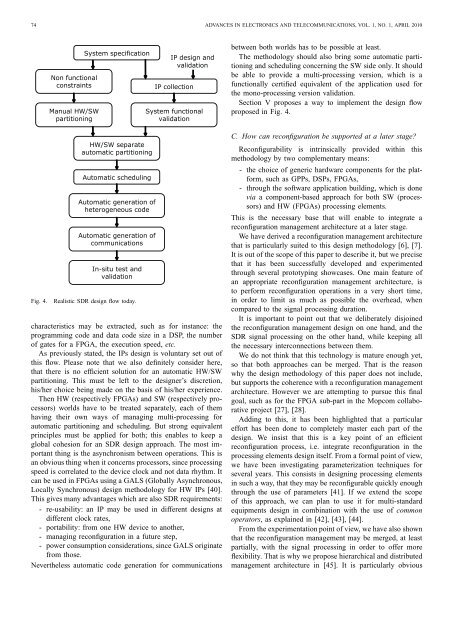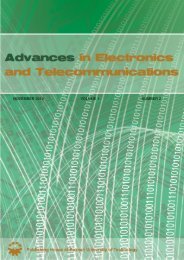channel - Advances in Electronics and Telecommunications
channel - Advances in Electronics and Telecommunications
channel - Advances in Electronics and Telecommunications
You also want an ePaper? Increase the reach of your titles
YUMPU automatically turns print PDFs into web optimized ePapers that Google loves.
74 ADVANCES IN ELECTRONICS AND TELECOMMUNICATIONS, VOL. 1, NO. 1, APRIL 2010<br />
Non functional<br />
constra<strong>in</strong>ts<br />
Manual HW/SW<br />
partition<strong>in</strong>g<br />
System specification<br />
HW/SW separate<br />
automatic partition<strong>in</strong>g<br />
Automatic schedul<strong>in</strong>g<br />
Automatic generation of<br />
heterogeneous code<br />
Automatic generation of<br />
communications<br />
In-situ test <strong>and</strong><br />
validation<br />
Fig. 4. Realistic SDR design flow today.<br />
IP design <strong>and</strong><br />
validation<br />
IP collection<br />
System functional<br />
validation<br />
characteristics may be extracted, such as for <strong>in</strong>stance: the<br />
programm<strong>in</strong>g code <strong>and</strong> data code size <strong>in</strong> a DSP, the number<br />
of gates for a FPGA, the execution speed, etc.<br />
As previously stated, the IPs design is voluntary set out of<br />
this flow. Please note that we also def<strong>in</strong>itely consider here,<br />
that there is no efficient solution for an automatic HW/SW<br />
partition<strong>in</strong>g. This must be left to the designer’s discretion,<br />
his/her choice be<strong>in</strong>g made on the basis of his/her experience.<br />
Then HW (respectively FPGAs) <strong>and</strong> SW (respectively processors)<br />
worlds have to be treated separately, each of them<br />
hav<strong>in</strong>g their own ways of manag<strong>in</strong>g multi-process<strong>in</strong>g for<br />
automatic partition<strong>in</strong>g <strong>and</strong> schedul<strong>in</strong>g. But strong equivalent<br />
pr<strong>in</strong>ciples must be applied for both; this enables to keep a<br />
global cohesion for an SDR design approach. The most important<br />
th<strong>in</strong>g is the asynchronism between operations. This is<br />
an obvious th<strong>in</strong>g when it concerns processors, s<strong>in</strong>ce process<strong>in</strong>g<br />
speed is correlated to the device clock <strong>and</strong> not data rhythm. It<br />
can be used <strong>in</strong> FPGAs us<strong>in</strong>g a GALS (Globally Asynchronous,<br />
Locally Synchronous) design methodology for HW IPs [40].<br />
This gives many advantages which are also SDR requirements:<br />
- re-usability: an IP may be used <strong>in</strong> different designs at<br />
different clock rates,<br />
- portability: from one HW device to another,<br />
- manag<strong>in</strong>g reconfiguration <strong>in</strong> a future step,<br />
- power consumption considerations, s<strong>in</strong>ce GALS orig<strong>in</strong>ate<br />
from those.<br />
Nevertheless automatic code generation for communications<br />
between both worlds has to be possible at least.<br />
The methodology should also br<strong>in</strong>g some automatic partition<strong>in</strong>g<br />
<strong>and</strong> schedul<strong>in</strong>g concern<strong>in</strong>g the SW side only. It should<br />
be able to provide a multi-process<strong>in</strong>g version, which is a<br />
functionally certified equivalent of the application used for<br />
the mono-process<strong>in</strong>g version validation.<br />
Section V proposes a way to implement the design flow<br />
proposed <strong>in</strong> Fig. 4.<br />
C. How can reconfiguration be supported at a later stage?<br />
Reconfigurability is <strong>in</strong>tr<strong>in</strong>sically provided with<strong>in</strong> this<br />
methodology by two complementary means:<br />
- the choice of generic hardware components for the platform,<br />
such as GPPs, DSPs, FPGAs,<br />
- through the software application build<strong>in</strong>g, which is done<br />
via a component-based approach for both SW (processors)<br />
<strong>and</strong> HW (FPGAs) process<strong>in</strong>g elements.<br />
This is the necessary base that will enable to <strong>in</strong>tegrate a<br />
reconfiguration management architecture at a later stage.<br />
We have derived a reconfiguration management architecture<br />
that is particularly suited to this design methodology [6], [7].<br />
It is out of the scope of this paper to describe it, but we precise<br />
that it has been successfully developed <strong>and</strong> experimented<br />
through several prototyp<strong>in</strong>g showcases. One ma<strong>in</strong> feature of<br />
an appropriate reconfiguration management architecture, is<br />
to perform reconfiguration operations <strong>in</strong> a very short time,<br />
<strong>in</strong> order to limit as much as possible the overhead, when<br />
compared to the signal process<strong>in</strong>g duration.<br />
It is important to po<strong>in</strong>t out that we deliberately disjo<strong>in</strong>ed<br />
the reconfiguration management design on one h<strong>and</strong>, <strong>and</strong> the<br />
SDR signal process<strong>in</strong>g on the other h<strong>and</strong>, while keep<strong>in</strong>g all<br />
the necessary <strong>in</strong>terconnections between them.<br />
We do not th<strong>in</strong>k that this technology is mature enough yet,<br />
so that both approaches can be merged. That is the reason<br />
why the design methodology of this paper does not <strong>in</strong>clude,<br />
but supports the coherence with a reconfiguration management<br />
architecture. However we are attempt<strong>in</strong>g to pursue this f<strong>in</strong>al<br />
goal, such as for the FPGA sub-part <strong>in</strong> the Mopcom collaborative<br />
project [27], [28].<br />
Add<strong>in</strong>g to this, it has been highlighted that a particular<br />
effort has been done to completely master each part of the<br />
design. We <strong>in</strong>sist that this is a key po<strong>in</strong>t of an efficient<br />
reconfiguration process, i.e. <strong>in</strong>tegrate reconfiguration <strong>in</strong> the<br />
process<strong>in</strong>g elements design itself. From a formal po<strong>in</strong>t of view,<br />
we have been <strong>in</strong>vestigat<strong>in</strong>g parameterization techniques for<br />
several years. This consists <strong>in</strong> design<strong>in</strong>g process<strong>in</strong>g elements<br />
<strong>in</strong> such a way, that they may be reconfigurable quickly enough<br />
through the use of parameters [41]. If we extend the scope<br />
of this approach, we can plan to use it for multi-st<strong>and</strong>ard<br />
equipments design <strong>in</strong> comb<strong>in</strong>ation with the use of common<br />
operators, as expla<strong>in</strong>ed <strong>in</strong> [42], [43], [44].<br />
From the experimentation po<strong>in</strong>t of view, we have also shown<br />
that the reconfiguration management may be merged, at least<br />
partially, with the signal process<strong>in</strong>g <strong>in</strong> order to offer more<br />
flexibility. That is why we propose hierarchical <strong>and</strong> distributed<br />
management architecture <strong>in</strong> [45]. It is particularly obvious







